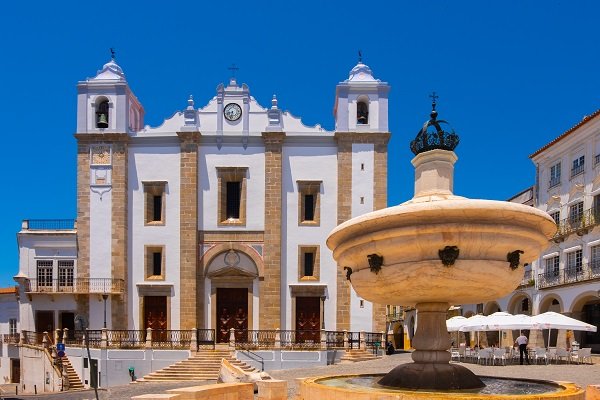Not too long ago Vexillologist Roman Mars named the Amsterdam coat of arms the "most badass city flag in the world.” And, it is pretty cool... Three Xs. But indulge me, if you will, and look at a few in Portugal's Alentejo that just might give the Dutch a run for their money.
Let’s start in the Alentejo's main city - Évora. The coat of arms of Évora is not for the faint hearted - you can see centuries old versions carved into stone around the city. The city flag flies proudly in front of the city hall, but its design is macabre.
In the center we see the knight Geraldo Geraldes (Geraldo Sem Pavor, the Fearless), on horseback hoisting a bloody sword. Geraldo took the city from the Arabs in the 12th century. Not far from his horse are two severed heads; a Moorish man and woman, apparently decapitated by his sword. The coat of arms proclaims "Mui Nobre e Sempre Leal Cidade de Évora '' - or the Most Noble and Always Loyal City of Evora, high praise in the day. Today, Geraldo is a legend, and the main square of Évora bears his name. And the statue shows the knight holding high, you got it, a severed head. An account of Geraldo’s taking of Évora in 1165 helps to explain the gory coat of arms:
Geraldo was a man of rank, who put himself at the head of a lawless gang. One dark evening he snuck into Évora, which then belonged to the Arabs. He killed the sentinels of one of the gates, which he opened to his companions, who soon overcame the city guards. The king pardoned Geraldo for past crimes, and made him governor of Évora. A knight with a sword in one hand and two heads in the other would become the symbolic bearing of the city.
Santiago do Cacém is a hill town, well fortified and linked to the Order of Santiago,a religious military-religious founded in 1160 to protect pilgrims on their way to Santiago de Compostela. But Santiago’s memorable coat of arms doesn’t include the traditional sword-cross of the order. No, it depicts a Christian knight mounted on a horseback with the corpse of a dead Moor lying before him, still clutching his sword. Now, this symbol is all over the city, including on green city trash cans. The story? Well, this was a place of battles. The town fell to Portugal's founding king Afonso Henriques in 1158, but was soon retaken. The knights of the Order of Santiago were given the job of taking it back in the early 13th century. And after a bloody fight, it was named Santiago do Cacém, after the Order of Santiago. Cacém derives from the Arab name for the town, Kassen. The coat of arms reflects the bloody fight for Santiago, and the stone cold courage of its knights.
Last stop on our badass tour - the charming and noteworthy town of Moura (the coat of arms calls it notável). An elegant town with a haunting coat of arms. The city shield shows a fine castle tower, and at its base, lies the body of a young Arab princess. This celebrates the tragic end of a Moorish princess who threw herself off from the castle tower. The legend says that she was betrothed to wed a prince from a nearby town. But the prince’s wedding party was ambushed by Christina knights, who dressed in their clothes - and were admitted into the city walls. Then they slaughtered the defenders… Seeing this tragedy, the princess jumped to her death from the castle tower. The conquering Christians were so moved by her death that they renamed the town after her: Moura. All due respect to Amsterdam, but that is badass.



